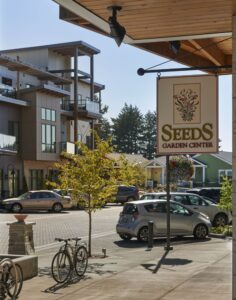Projects
The Courtyards at Lowman
Chapin, SC
The Courtyards at Lowman are a collection of pocket neighborhoods that provide a new monthly rental option for seniors at a middle income level. The first phase is comprised of two pocket neighborhoods, each offering ten unique cottage-style apartment homes with common spaces to encourage a sense of shared experience among residents. The grouping of ten homes helped to increase density on the eight-acre site while maintaining the single-story cottage-style desired in the region. The site plan envisions future phases of pocket neighborhoods that are being constructed incrementally.
Middle Market Pocket Neighborhoods
The individual apartments range in size from 740 to 1,018 square feet. The open floor plan models are designed for maximum flow and natural light. Included features include walk-in closets, accessible bathing and side-by-side washers and dryers. Each home has both an open courtyard, perfect for socializing with neighbors, and a more private rear porch for relaxing or charging a golf cart. A dedicated vehicle parking spot is provided just a short walk away.
Creating a Sense of Community
A 520 SF clubroom is included in each pocket neighborhood to provide a space where residents can gather together, entertain guests or enjoy a range of potential wellness, lifelong learning or other programming. Each apartment cluster surrounds a landscaped common courtyard with livable porches to enhance outdoor recreation and socializing with neighbors.
Outdoor Amenities
A new patio with outdoor fireplace was added between the new pocket neighborhoods and existing community spaces. Outdoor walking paths and sidewalks connect residents living in the pocket neighborhoods to the Heritage at Lowman wellness center which offers bistro dining, a full fitness center and other resident services and amenities.
More about Senior Housing News Architecture and Design Award
Photography Credit: Nathan Cox Photography
Arbor Acres Houses on Bayberry
Winston-Salem, NC
New pocket neighborhoods of up to five cottage clusters responds to the need for moderately sized, higher density homes. These replacement senior living residences are being inserted near the center of the campus over several phases of construction.
Creating Garden-Focused Pocket Homes
The project celebrates the community’s courtyard gardens with a new interpretation of building placement and wraparound porches that expand a sense of ownership while providing community connectivity. The garden space between the buildings gives the structures a sense of freedom and independence while deep porches and a system of covered walkways offer residents a safe, weather-protected connection to the common areas at the heart of the community.
The covered front porches serve as a catalyst for neighbors to connect with each other and the shared gardens encourage community among the residents living around them. Each Bayberry cluster features its own color palette and small-scale garden commons to promote a sense of identity and commonality between residents.
Modestly-Sized Homes for an Affordable Price Point
Each cluster consists of two1-bedroom with den patio homes joined as a duplex and two 2-bedroom patio homes. The homes reflect a high level of thoughtfulness and detailing in a relatively small square footage at a modest price point. Aimed at residents who require less space, but prefer living in a house rather than an apartment, the Houses on Bayberry feature efficient, marketable floor plans.
The one and two-bedroom units are approximately 1,000 SF and 1,100 SF respectively and are designed to provide an economical independent housing option. Despite their small size, the houses deliver handicap accessibility, sheltering porches, adjacent parking, cathedral ceilings with dormer lighting, shared garden spaces and covered connections to common areas. It all works to promote a sense of community.
Virtually every provider strives to provide affordable, low-cost housing options for their constituents. Few are able to achieve this goal without sacrificing aesthetics. This project achieved the owner’s affordability goals without compromising design integrity. Despite their small size and affordability, the Houses on Bayberry deliver handicap accessibility, sheltering porches, adjacent parking, walk-in closets, cathedral ceilings generously lit from above with dormer skylights and covered connections to common areas. The Bayberry house clusters are arranged to create small-scale public spaces or garden commons fostering a sense of community and outdoor connections.
Awards: Exhibition and Publication in the AIA/LeadingAge Design for Aging Review
Photo Credit: Larry Lefever Photography
Rose Villa
Portland, OR
Master planning resulted in multi-phased campus updates and replacement housing. Phase 1 encompassed 76 “pocket neighborhood” cottages and loft-style apartments over new town center spaces. Main Street amenities, many of which are open to the surrounding community, include a bistro, coffee shop, garden center, art studio, wellness center and auditorium. New assisted living, replacement healthcare, children’s daycare, and additional pocket neighborhoods are anticipated for later phases.
Addressing the Steep Site with Appealing Pocket Neighborhoods
This senior living community, originally opened in 1960, was known for its lush landscaping and relaxed garden lifestyle. Its existing linear, one-story garden apartments had become dated and the steep 22-acre hillside site was challenging for older adults to navigate. The gradual replacement of all 263 residences began with the first phase of pocket neighborhoods.
These cottage-style active adult residences are organized around gardens stepping down the hillside. Each pocket neighborhood is comprised of seven homes overlooking an intimate courtyard. The result creates smaller, pedestrian-friendly neighborhoods which capitalize on garden connections and outdoor views. The “over-under” cottages in each pocket neighborhood maximize site utilization while providing compact floor plans that are sized to be affordable, yet maintain open and livable spaces with appealing views in multiple directions.
 Connecting with the Surrounding Community Through New Main Street Amenities
Connecting with the Surrounding Community Through New Main Street Amenities
The pocket neighborhoods transition up to a new Main Street and Town Center with amenity spaces at street level and loft apartment living on the upper levels. The loft apartments provide a residential option for consumers who prefer “downtown” living with interior connection to common spaces. Situated at the highest point of the site overlooking the Willamette River, Main Street provides a unique and appealing first impression of the campus, as well as reinforcing a sense of place within the larger community.
To provide a true downtown ambience, the street level amenities, such as the bistro and garden center, are directly accessible from both the street and internal corridors. A wine bar is envisioned for the rooftop garden overlooking Main Street and providing views to the river. With the completion of the first phase of updates, Rose Villa provides an appealing, accessible garden setting, as the community was originally conceived.
Awards: Award of Merit, AIA/LeadingAge Design for Aging Review, | Honorable Mention – Independent Living; Senior Housing News Design Awards | Merit Award in the Environments for Aging Design Showcase
Photo Credit: Nathan Cox Photography, Steve Wanke Photography
Learn more about Wellness